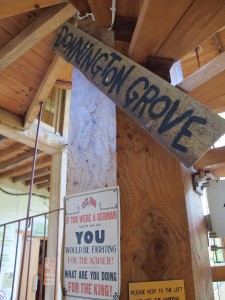World War One Trench Geography and Journey’s End
1 October 2014
 During the research and rehearsals for The Watermill Theatre’s production of Journey’s End, we discovered that the forces named the trenches on the Western Front, both for practical reasons and to give them a connection to home. As part of our research we looked at area’s around Newbury where large groups of men who ‘took the Kings Shilling,’ the term given to those agreeing to serve within the forces dating back to 17th Century English Civil War, came from. To this end we have christened the trench and entrances to and from the auditorium in acknowledgement of this with names including Donnington Grove, Wash Common, Craven Estate and Pear Tree Lane.
During the research and rehearsals for The Watermill Theatre’s production of Journey’s End, we discovered that the forces named the trenches on the Western Front, both for practical reasons and to give them a connection to home. As part of our research we looked at area’s around Newbury where large groups of men who ‘took the Kings Shilling,’ the term given to those agreeing to serve within the forces dating back to 17th Century English Civil War, came from. To this end we have christened the trench and entrances to and from the auditorium in acknowledgement of this with names including Donnington Grove, Wash Common, Craven Estate and Pear Tree Lane.
“Every trench was originally built by soldiers with sandbags. At the beginning of every long trench was the name of a street. Every trench had it.” William G Holmes, British Private – WW1
From the autumn of 1914 there was a virtual stalemate on the Western Front and the unforeseen phenomenon of trench warfare soon set in. Both sides constructed elaborate dug out systems protected from attack by barbed wire. Some sections of the British trench system read like a Monopoly board, with names such as Park Lane, Bond Street, Clapham Junction and Piccadilly Circus and locations familiar to the soldiers. With the naming of the trenches, the front line began to form its own geography with minor hills and valleys, previously nameless, being christened. Some hills were named for their height in metres, such as ‘Hill 60.’
Battlefield features were given a descriptive name “Polygon Wood” near Ypres or “Lone Pine”; a whimsical name “Sausage Valley” and “Mash Valley” on the Somme, or the name of a soldier “Monash Valley” at Anzac named after General John Monash. Prefixing a feature with “Dead Man’s…” was also popular for obvious reasons, such as “Dead Man’s Road” leading in to Pozières, or “Dead Man’s Ridge” at Anzac. There were numerous trench networks named “The Chessboard” or “The Gridiron” because of the pattern they described.
British regular divisions habitually named their trenches after units, which resulted in names such as “Munster Alley” (Royal Munster Fusiliers), “Black Watch Alley” (Black Watch Regiment) and “Border Barricade” (Border Regiment). The Anzacs tended to name features after soldiers (“Plugge’s Plateau”, “Walker’s Ridge”, “Quinn’s Post”, “Johnston’s Jolly”, “Russell’s Top”, “Brind’s Road” and so forth).
Source: Imperial War Museum: Voices of the First World War / Wikipedia.org.uk / www.1914-1918.net
“This story is to be neither an accusation nor a confession, and least of all an adventure, for death is not an adventure to those who stand face to face with it. It will try simply to tell of a generation of men who, even though they may have escaped its shells, were destroyed by the war.” All Quiet on the Western Front by Erich Maria Remarque. 1929.
Neil Bull
Assistant Director
